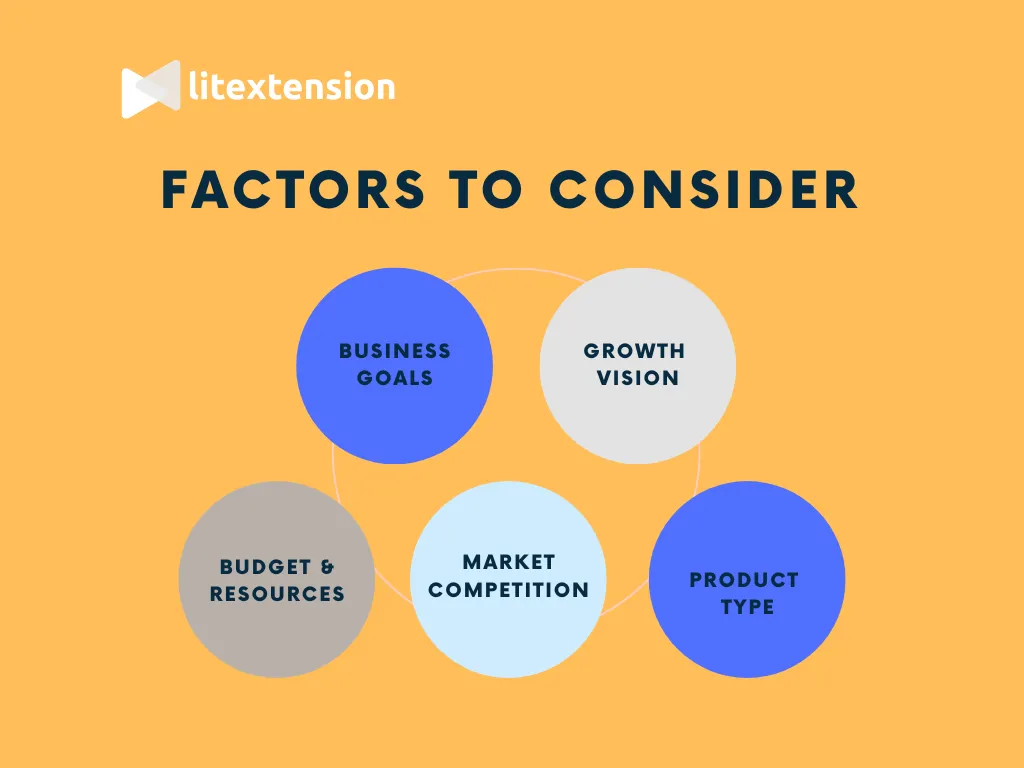If you’re planning to sell online, you’ve probably faced a very familiar dilemma: Should I build my own store on Shopify, WooCommerce,… or sell through a marketplace like Amazon or Etsy? After all, though both an eCommerce platform vs marketplace promise visibility and revenue, they work in completely different ways behind the scenes!
In this guide, we’ll take a closer look at the difference between eCommerce platform and online marketplace.
Specifically, this article will discuss:
- Key characteristics of an eCommerce platform
- Key characteristics of a marketplace
- 6 differences between an eCommerce platform vs marketplace
- Which solution is better for your business
- Criteria to choose between an eCommerce Platform vs marketplace
By the end, you’ll be able to decide not just where to sell, but how to grow in the long run. Let's get started!
What are eCommerce platform key characteristics? (e.g, Shopify, BigCommerce)
An eCommerce platform is a software that enables businesses to create and run online stores with full control (e.g, Shopify, BigCommerce, WooCommerce,..). It provides a centralized system for a business to manage its virtual storefront, sales operations, and customer interactions, making it possible to sell products and services over the internet.
Before exploring what defines an eCommerce platform (and later on, the difference between an eCommerce platform vs marketplace), it’s helpful to look at its general strengths and limitations:
Pros | Cons |
Full ownership and control over branding, content, and customer data | Requires technical knowledge or external help to build and maintain |
Highly customizable with integrations, apps, and themes | Initial setup costs and subscription fees can be higher than marketplace entry |
Enables long-term customer relationships and brand equity | Traffic generation and marketing are the merchant’s responsibility |
1. Independent store ownership
An eCommerce platform allows merchants to build and operate their own online store without relying on a central authority.
Businesses register a domain name, customize design, upload products, and directly manage pricing, policies, and promotions. The platform itself provides the tools and infrastructure (hosting, checkout, analytics), but the merchant owns the store. Simply put, the business relationship exists directly between the store and its customers, not mediated by any third party.
2. Subscription-based revenue structure
Most eCommerce platforms follow a SaaS (Software-as-a-Service) model, meaning merchants pay a recurring subscription fee that grants access to software, hosting, and support.
Some platforms also offer tiered plans that scale with store size or sales volume, plus optional costs for plugins, themes, or payment processing. This pricing structure gives merchants predictable expenses and flexibility to grow: they pay for functionality and performance, not for every transaction. As a result, their profit margins are directly linked to their business performance rather than platform commission.
3. Full customization and data ownership
Unlike marketplaces, where sellers must follow fixed layouts and policies, eCommerce platforms offer more freedom to shape every part of the user experience.
Merchants can modify design, navigation, product presentation, and even code (in open-source systems like WooCommerce). They also retain ownership of their customer data, including email lists, purchase history, and behavior analytics.
What are online marketplace key characteristics? (e.g, Amazon, Etsy,…)
An online marketplace (for example, Amazon or Etsy) is a large-scale selling environment where sellers can set up their own storefronts.
This model allows you to reach a massive customer base. However, it also means operating under the platform’s rules and facing intense competition from other sellers offering similar products on the same marketplace.
Here’s how its main advantages and disadvantages compare.
Pros | Cons |
Full ownership and control over branding, content, and customer data | Requires technical knowledge or external help to build and maintain |
Highly customizable with integrations, apps, and themes | Initial setup costs and subscription fees can be higher than marketplace entry |
Enables long-term customer relationships and brand equity | Traffic generation and marketing are the merchant’s responsibility |
1. Multi-seller environment
A marketplace connects multiple independent sellers with buyers on a single platform. Sellers create listings within the marketplace’s framework and follow standard templates and rules.
The marketplace operator manages traffic, payment processing, customer protection, and sometimes even logistics (e.g., fulfillment centers). This shared environment allows sellers to reach customers quickly but limits their ability to control how products appear or how their brand is represented. All interactions occur within the marketplace’s ecosystem, not on a seller-owned website.
2. Transaction-based revenue system
Marketplaces earn revenue primarily through transaction fees and commissions. Each completed sale generates a small percentage that goes to the marketplace operator.
Some also charge additional fees for listing products, running ads, or subscribing to premium seller accounts. This system means the marketplace’s revenue scales with the number of transactions processed, encouraging the operator to attract more buyers and sellers. Though sellers benefit from the platform’s built-in audience, they must share a portion of every sale – a trade-off between reach and profit.
3. Centralized branding and customer experience
In a marketplace, the overall customer experience is designed and controlled by the operator. The brand identity customers remember (such as Amazon, Shopee, or eBay) belongs to the marketplace, not the individual sellers. Hence, product pages follow uniform templates; customer communication, dispute handling, and feedback systems are all centralized.
What are the differences between eCommerce platform and online Marketplace?
- Interaction structure: eCommerce platforms support a direct merchant–customer model, while marketplaces connect many sellers and buyers in one centralized ecosystem.
- Revenue model: platforms usually monetize access, tools, or subscriptions, whereas marketplaces earn mainly through per-transaction commissions and seller fees.
- Value creation: platforms empower merchants to build independent brands, while marketplaces create value by aggregating large pools of buyers and sellers.
- Branding control: merchants have full brand ownership on platforms but must operate under the marketplace’s standardized identity.
- Customer relationship: platforms allow full control of customer data and support, but marketplaces mediate interactions, limiting direct relationship-building.
- Marketing: platform merchants can run diverse, customized marketing strategies, while marketplace sellers rely on built-in ads and compete in crowded product listings.
Type of interaction

For starters, the most fundamental difference between an eCommerce platform vs marketplace lies in how people interact within them.
An eCommerce platform functions as a complete system that allows a business to create and manage its own online store. In this model, there are only two main parties involved: the merchant and the customer.
The platform provider (such as Shopify, WooCommerce, or BigCommerce) simply offers the infrastructure and tools, like website templates, checkout systems, and payment gateways. Meanwhile, the merchant handles everything else, from product listings and marketing to customer support and fulfillment.
By contrast, a marketplace serves as an intermediary between multiple sellers and buyers, all operating within one centralized system. Amazon, eBay, and Shopee are good examples. Here, transactions take place under the marketplace’s structure: sellers list products, buyers make purchases, and the marketplace handles payments, logistics, and sometimes even customer service. The interaction is standardized and transactional; buyers engage mainly with the marketplace brand, not with individual sellers.
Revenue model
These structural differences naturally shape how an eCommerce platform vs marketplace earns money.
A marketplace primarily monetizes each transaction. Its core engine is commissions or referral fees taken per sale, often supplemented by listing fees, seller subscriptions, paid promotions, and logistics or fulfillment charges where offered. In other words, revenue scales directly with GMV and the number of completed orders.
Likewise, an eCommerce platform can also earn from transaction fees in certain contexts. For example, app stores take a cut of app sales or in-app purchases, and platforms add a margin on payment processing.
Still, in most other cases, platforms also typically rely on diversified revenue streams beyond pure per-sale commissions: advertising (e.g., social platforms), subscriptions (e.g., premium tiers like LinkedIn Premium or SaaS plans for store software), and in-app purchases (e.g., gaming ecosystems).
Simply put, marketplaces monetize the sale itself, whereas platforms usually monetize access, tools, or audience, while still taking a transaction cut in specific product categories.

Value creation
Next, the way value is created in an eCommerce platform vs marketplace also differs significantly.

A marketplace generates value through aggregation. By bringing together a large pool of sellers and buyers, it creates convenience and efficiency for both sides. Buyers enjoy variety, competitive prices, and quick transactions, whereas sellers gain access to an existing audience without needing to build traffic from scratch. The more people join and interact, the more valuable the marketplace becomes.
In contrast, an eCommerce platform creates value through empowerment. Instead of connecting existing demand and supply, it provides merchants with the tools to build and differentiate their own online presence. Merchants can design their websites, customize their branding, and develop marketing strategies tailored to their audience. The platform’s value grows as merchants innovate by launching new products, using advanced integrations, and improving customer experiences.
In short, marketplaces create collective value by connecting many users, while eCommerce platforms create individual value by enabling independence and growth.
Control over branding
Finally, the most visible distinction lies in branding control.
As mentioned briefly earlier, on a marketplace, sellers operate under the marketplace’s identity.
Product pages follow standard templates, and branding opportunities are limited. Buyers usually remember the marketplace name (like Amazon or Lazada) rather than the specific seller. Though this gives sellers exposure to a massive audience, it also means they sacrifice brand ownership. Customer data and communication channels are typically controlled by the marketplace, making it harder for sellers to build direct relationships or long-term loyalty.
An eCommerce platform, however, offers complete ownership over branding and customer experience. Merchants can use their own domain name, customize every visual element, and control how their brand communicates with customers. They also have full access to customer data, allowing for personalized marketing, retargeting, loyalty programs, etc. Such autonomy enables merchants to build long-term brand equity and distinct identity – something a shared marketplace environment cannot offer.

Customer relationship
The level of control over customer relationships is another clear difference between an eCommerce platform and a marketplace. On a marketplace, sellers rarely interact directly with buyers. Most communication, support, and post-purchase touchpoints are mediated or controlled by the marketplace itself. As a result, sellers often lack access to full customer data, cannot freely implement retention strategies, and have limited opportunities to build emotional connection or long-term loyalty. The relationship is mostly transactional, short-term, and dependent on the marketplace’s rules.
Meanwhile, an eCommerce platform gives merchants complete ownership of the customer relationship from start to finish. They can choose how to handle customer support, personalize interactions, create loyalty programs, and tailor the overall shopping experience. Full access to customer data allows for detailed segmentation, retargeting, and nurturing. This level of autonomy helps businesses build deeper trust, stronger brand affinity, and repeat purchases – something that is difficult to achieve within a shared marketplace ecosystem.
Marketing
Marketing works very differently between an eCommerce platform and a marketplace because each environment shapes how merchants can reach and influence customers. On marketplaces, marketing opportunities are often limited and highly competitive. Sellers mostly rely on the marketplace’s internal advertising tools – sponsored listings, paid placements, vouchers, and flash sales – to gain visibility. Even then, they must compete directly with thousands of other sellers offering similar products. Since branding is restricted, most marketing revolves around pricing, ranking, and algorithm-driven exposure rather than strategic brand-building.
On an eCommerce platform, merchants have far greater freedom to design and execute their marketing strategies. They can optimize their website for SEO, run paid ads across multiple channels, develop long-form content, build email funnels, and experiment with creative campaigns. Because they control their own brand identity and customer data, they can craft a unique narrative and offer personalized experiences that drive long-term growth. Instead of competing in a crowded marketplace feed, merchants can build a loyal audience of their own and shape how customers perceive their business.
How to Choose between eCommerce Platform vs Online Marketplace for Your Business?
To choose between an eCommerce platform vs marketplace, you need to think carefully about your business goals, resources, and growth potential. Below are four key criteria to help guide your decision:

Business goals and growth vision
Ask yourself: What is my main objective?
If your goal is to make sales quickly and validate your products in the market, a marketplace makes sense. Just like renting a stall in a busy market, you instantly get foot traffic, but you don’t control the space. You’ll rely on marketplace policies and must compete for visibility among many sellers.
On the other hand, if your goal is to build a sustainable brand that customers recognize and return to, an eCommerce platform is more suitable. Here, you’re not only selling products but also creating a business asset that grows in value. You can customize every aspect of your store, from the visuals to the tone of communication, and build customer trust over time.
Budget and operational resources
Think realistically about what you can afford, not just in money, but in time and skills.
A marketplace is low-cost to start because the operator handles technical tasks like hosting, payment, and security. You simply list your products and start selling. The downside is that you’ll pay commissions per sale, which reduces your profit margins over time.
Meanwhile, an eCommerce platform requires a higher initial investment, including subscription fees, domain purchase, store design, and marketing. You’ll also need to manage fulfillment and customer service. However, your ongoing costs become more predictable, and you keep most of your profits.
Market competition and product type
Last but not least, consider how crowded your industry is and what sets your product apart.
In a marketplace, competition is fierce because customers can compare prices and products instantly. If your business depends on competitive pricing or high-volume sales (like electronics accessories, clothing, or daily-use goods), marketplaces are ideal since you benefit from their existing traffic and user trust.
However, if your products are unique, premium, or brand-driven, a platform allows you to showcase their value more effectively. You can design a branded shopping experience that highlights craftsmanship, storytelling, or exclusivity, all of which usually get lost in a marketplace’s standardized listing.
Essentially, marketplaces are better for selling common, price-sensitive items. Meanwhile, platforms are better for differentiated or high-value products.
eCommerce Platform vs Marketplace: FAQs
What is the difference between a marketplace and an eCommerce platform?
The main difference lies in ownership and structure. A marketplace is a centralized system operated by a third party that connects multiple independent sellers with buyers. An eCommerce platform, on the other hand, is a software solution that allows an individual business to build and manage its own online store.
Is Amazon a marketplace or eCommerce?
Amazon is primarily a marketplace, not a traditional eCommerce platform. It allows millions of independent sellers to list and sell products directly to customers through Amazon’s ecosystem. Amazon handles payment processing, order fulfillment, and customer service in many cases (especially through Fulfillment by Amazon, or FBA).
Is a marketplace considered eCommerce?
Yes, absolutely. A marketplace is a form of eCommerce, but not the only one. The term eCommerce broadly refers to any form of buying and selling conducted online. Within that category, there are different models, including single-vendor eCommerce stores (built on platforms like Shopify or WooCommerce) and multi-vendor marketplaces (like Amazon or Etsy).
Is Facebook Marketplace an eCommerce platform?
Facebook Marketplace is not a full eCommerce platform; it’s a peer-to-peer marketplace feature within Facebook’s social network. It allows users to list and sell items locally or through shipping, but it doesn’t provide complete eCommerce functionality such as branded storefronts, custom domains, or integrated marketing tools.
eCommerce Platform vs Online Marketplace: Which Is For You?
As you can see, both an eCommerce platform vs marketplace can be profitable, but each suits a different stage and type of business.
If you’re a new or small seller, a marketplace offers the fastest path to selling online.
You don’t need to worry about building a website, buying a domain, or handling payment systems; everything is ready for you. The marketplace already has a steady flow of buyers, so you can reach customers immediately and start generating revenue quickly. Plus, this model works well if your priority is visibility and sales rather than brand-building.
On the other hand, for established businesses, brand-focused entrepreneurs, or manufacturers that want to own customer relationships and present a distinct image, an eCommerce platform is the better route.
You’ll need to invest more time and money upfront (creating your store, setting up payment gateways, driving traffic yourself, etc.), but you gain full control over your business. You decide how your products look, how your brand is represented, and how customers experience your store. Over time, this control allows you to build brand loyalty and grow sustainably without depending on a third-party marketplace.
For more eCommerce tips, check out our blog or join our Facebook Community.

